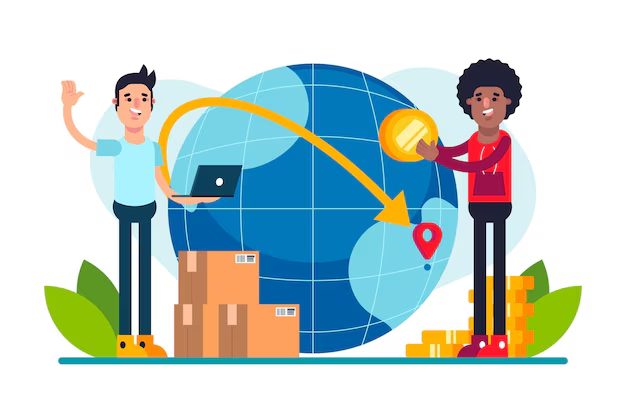International trade is the backbone of global economic integration, allowing goods, services, and capital to move across borders. It encourages cooperation, raises efficiency, and widens consumer choice. International trade, however, is complex in its nuances, driven both by the theoretical underpinnings of economics and by practical challenges. This blog covers the basics, benefits, and challenges of international trade and how it affects a wide perspective.
What is International Trade?
International trade, in its very basic sense, refers to the exchange of goods, services, and capital across countries. It assumes mainly two forms:
- Exports: The sale of goods or services to foreign markets.
- Imports: These are goods or services bought from foreign markets.
In return, it enables countries to benefit from the comparative advantages, a concept explained by the economist David Ricardo. A country specializes in producing goods that they enjoy the highest comparative efficiency in the production and then exchanges those goods for other goods costly to produce at home. Comparative advantage is an important concept developed within modern trade theory.
England’s efficiency in cloth production and Portugal’s dominance in wine production created mutual benefits through trade. The same case occurs in the present global economy, where countries such as China have taken advantage of their efficient labour in making consumable products while the U.S. invests its specialization in technology intensive products.
Why Countries Trade
There are several reasons why countries take part in international trade:
- Availability of Resources:
Resources are not available with the country for meeting the domestic demand. For example, oil-importing countries need to depend on international trade in order to meet their energy demands.
- More Variety and Better Quality:
Trade has created availability of all kinds of goods and services. For instance, bananas from Costa Rica, coffee from Brazil, and wine from South Africa are found in almost every supermarket around the world.
- Economic Growth:
By opening up to markets, it encourages innovation; hence, productivity and a spur in growth are stimulated.
International trade has modernized the global economies; as can be seen from different types of products that are traded- one ranging from crude oil and automobiles to electronics and machinery, just showing how similar the industries in the world are.
Benefits of International Trade
- Higher Efficiency and Specialization
Goods produced tend to be much more efficient if countries focus on their comparative advantages. Capital-rich countries like Germany will specialize in machinery, and labour-abundant countries like Bangladesh will focus on textiles.
- Economic Growth and Employment Opportunities
Global trade widens the markets and thus creates jobs. According to the International Monetary Fund, trade reforms assure more competition and consequently bring in better technologies and innovative products.
- Competitive Price
It should, however, be noted that international trade does indeed increase competition-mostly for consumer goods-and that one common effect of such increased competition is driving down consumer prices. In such a way, consumers from both the developed and developing nations can profit from this fact.
Challenges Facing International Trade
- Trade Barriers
Some governments do, from time to time, put in place tariffs, quotas, and subsidies with a view to save their industries. This, in real sense, is a relief to local producers in the short run, but in the end distorts world markets and reduces total economic efficiency.
- Environmental Issues
The environmental impact of international trade can also not be looked away from. Sometimes localized productions are more environmentally friendly than global trade. Yet, a trade-off has to be there, in terms of carbon emissions through transportation.
- Inequality between Nations
Trade is usually more biased towards the developed nations than the developing ones. For instance, low-income countries export more commodities facing high trade barriers in industrialized economies than vice versa, which ultimately reduces their growth prospects.
Types of International Trade
International trade occurs in a lot of different forms; all of these have their role to play in the global economic dynamics.
- Trade in Goods
The most traditional form of trade, it includes the exchanging of raw materials, such as oil and minerals, for more completed products, like cars and electronic devices. Crude oil, cars, and phone devices are among the prominent products in the global exportation of goods.
- Trade in Services
Services trade includes such cross-border activities as tourism, financial consulting, and IT services. Indeed, a very good example would be the currently leading position of India in respect to the services related to information technologies, which are an example of how countries are able to make use of their relative strength.
- Trade in Investments
FDI or foreign direct investment is the part of trade that allows a company to set up its facilities abroad. It is a category of trade that fosters cooperation and leads to basically more integration of economies worldwide.
Role of Comparative Advantage
The theory of comparative advantage is the bedrock of international trade. Even in countries that enjoy absolute advantages, gains are only realized through specialization in the highest comparative advantages. For instance,
- Country A can either produce three kg of steel or two shirts in one hour.
- Country B can produce either one kilogram of steel or one shirt in an hour.
Trade allows the countries to specialize in what they are good at and thus gaining overall efficiency bestowments. The same principle, in fact, applies across industries and can explain why nations import products even for those commodities that they could have produced domestically.
Trade Policy Evolution
There have been a lot of important reforms in the world’s trade policies since World War II. The WTO has played an extremely active role in moving forward the principle of non-discrimination and the reduction of trade barriers. The negotiations in the Doha Round to further open up the markets have stalled, however.
Governments have to square up the benefit of trade against the fears of their people. Protectionist policies, like tariffs, protect industries but hurt growth in the end. For instance, frictions in trade between the United States and China have disrupted supply chains around the world.
The Future of International Trade
Global trade is constantly changing due to technology, changes in geopolitics, and environmentalism. Some new trends that seem on the horizon are the following:
- Digital Trade:
E-commerce and digital services have become so influential that they rewrite the conventional ways of trade.
- Sustainability:
Green trade policies have been trending today, most of them having an eco-friendly touch to all practices.
- Regional Agreements:
Most of these giants or trading blocs, like the European Union and the ASEAN, are forming closer economic ties.
Endnote
International trade is a strong driving force that definitely guarantees economic advancement, greater contact, and more novelty. Though to date there exist impediments to efficiently concluded trades and an environmental challenge which the detriments are outweighed, the efficiencies brought about by international trade create competitive pricing and access to wide varieties of goods and services. By embracing the principles of comparative advantage and sustainable practices, nations can help ensure that international trade continues to create prosperity for all.



